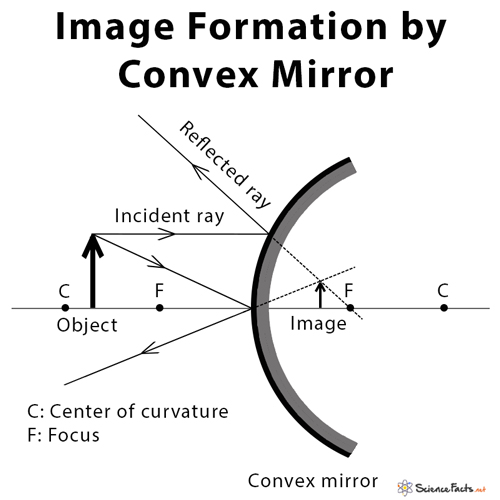A convex mirror is a round mirror that curves outward towards the light. Convex mirrors are used in rearview mirrors, magnifying glasses, and sunglasses to make light beams spread outwards. A convex mirror is a type of mirror that is curved. When the light bounces off the mirror, it spreads out. Convex mirrors are used in places where it is necessary to see large objects in smaller spaces.
One of the most notable uses of convex mirrors is in rearview mirrors in vehicles. The outward-curving shape allows them to provide a wider field of view, helping drivers see a larger area behind them and reducing blind spots. Additionally, convex mirrors are used in magnifying glasses to make objects appear larger than they actually are, and they’re also employed in sunglasses to help reduce glare.
What is Convex Mirror?
A convex mirror is a roundish mirror that curves outward at the center. Convex mirrors are curved outward while concave mirrors are curved inward. The curved mirror makes the light rays spread out when they bounce off its surface. In simpler words, the rays that are reflected move in different directions. This special feature of convex mirrors makes things in the images look smaller and closer than they really are.
Curved mirrors that bulge outwards are used in many different real-life situations because they have special qualities that help with seeing things clearly. Convex mirrors are often used as rearview mirrors in vehicles. These mirrors are shaped in a way that helps drivers see more of what’s behind their vehicle. This means they can see a bigger area and have fewer spots where they can’t see anything. Peripheral vision improvement makes driving safer and improves awareness of the traffic around us.
Image Formation by Convex Mirror
Image formation by Convex Mirror At Limitlessness: Behind the reflect, a virtual, erect, exceedingly lessened, and point estimate picture is shaped at the center when an protest is put at limitlessness.
Image formation by Convex Mirror Between limitlessness and the Pole(P) of Mirror: Behind the mirror, a virtual, decreased, and erect picture is shaped between the center of the raised reflect and the post. The picture gets shaped when an question is set at a constrained remove from the raised reflect.
Uses of Convex Mirrors
Rearview Mirrors in Vehicles: Convex mirrors are often used as rearview mirrors in vehicles. These curved mirrors help drivers see more of what’s behind them, making it easier to check for blind spots and see a bigger area. This makes driving safer and helps stop accidents from happening.
Security and Surveillance: Arched mirrors are regularly utilized in security and observation frameworks. Their capacity to supply a wide, all encompassing see makes them perfect for observing ranges where comprehensive perception is pivotal, such as in stores, shopping shopping centers, stopping parts, and other open spaces.
Street Security: Raised mirrors are utilized on streets, particularly at convergences and sharp twists, to improve perceivability for drivers. These mirrors permit drivers to expect oncoming activity or people on foot, in this way decreasing the probability of mishaps.
Security at Domestic: Arched mirrors can be introduced at the entrance of homes or carports to supply mortgage holders with a more extensive see of their environment. This makes a difference in distinguishing guests or potential interlopers from a remove.
Things to Remember
- A convex mirror is a spherical reflecting surface that bulges towards the light source.
- They only form virtual and erect images.
- The convex mirrors are used in places where objects are required to be viewed in smaller areas.
- The uses of convex mirrors are: In the hallway of buildings to avoid collisions, In sunglasses to reflect sunlight, To produce magnifying glasses, In vehicles as rearview mirrors, To ensure safety and privacy in ATMs, Malls, and roads
FAQs
A convex mirror curves outward, while a concave mirror curves inward. Convex mirrors cause light rays to spread out, resulting in smaller, virtual images, whereas concave mirrors can form both real and virtual images, depending on the object’s position.
Convex mirrors are frequently used in rearview mirrors of vehicles, security and surveillance systems, stores, parking lots, and road safety applications.
The outward-curved shape of convex mirrors provides a wider field of view, reducing blind spots and enhancing the driver’s ability to see surrounding traffic.
Convex mirrors always produce virtual, diminished images. The images formed are smaller than the actual object due to the spreading out of light rays upon reflection.
No, convex mirrors cannot form real images. The reflected rays never converge to a single point; therefore, the images formed are always virtual.
Convex mirrors are also used in art and photography for their unique visual effects and distortion properties, adding a creative dimension to artistic expression.
No, convex mirrors cannot focus light to a specific point like concave mirrors. They cause light rays to spread out, preventing the convergence needed for focusing.
Convex mirrors can lead to distorted images and do not provide fine details due to their spreading out of light. Additionally, they cannot form real images, which can limit their applications.
Conclusion
In conclusion, understanding the principles and applications of convex mirrors offers valuable insights into their significance in various aspects of our daily lives. The distinct outward-curved shape of convex mirrors imparts unique optical characteristics that find practical utility in a wide range of scenarios.
From upgrading street security through moved forward perceivability in vehicles’ rearview mirrors to invigorating security in open spaces and empowering productive observation, raised mirrors serve as fundamental devices for advancing security and mindfulness. Their capacity to supply a broader field of see makes them essential in avoiding mischances and encouraging viable checking.





















